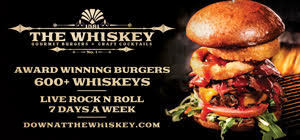When the Polonia Polish restaurant sign went up on US 17-92, old fans breathlessly hoped that it was the same folks who had won their hearts and bellies at the similarly named restaurant from Winter Park. It is.
Owner Rob Plummer told me by phone that he had to close the restaurant on Aloma because his chef went back to Poland. But the chef is back and all is well again.
You don’t have to be Polish to admire Polish food. You need only an appreciation for hearty fare whose origins come from the necessity to make do with what the earth and the seasons give you. This is farmland food, Eastern European style, where root vegetables like beets and carrots, and cured meats like kielbasa are used in abundance. And simple ingredients like flour, water and potatoes can be turned into something as splendid as pierogi.
And this is where something with a reputation as unflattering as a stuffed cabbage can be made into a delicacy that will change your mind about it forever.
Golabki, pronounced gowamki, is the name for the stuffed cabbage ($7.95). The pungent leaves were filled with a mixture of ground beef, pork and rice and covered with a tangy sauce of tomatoes. If you prefer, a mushroom sauce may be substituted.
Polonia features two types of pierogi ($7.50), the filled dumplings that are a staple of a Polish meal. You can get them with sauerkraut and mushroom or with potatoes and farmer cheese. Either version will be served topped with butter and covered with sweet caramelized onions and finished with a creamy dollop of sour cream. I liked both versions although I would probably tip the scales in favor of the potato filling because it seemed like a more substantial entrée.
One of my favorite dishes was the veal cutlet ($12.95). My guests and I could hear the cook in the kitchen pounding the cutlet, which was then coated with a breading and sauteed. The breading came out as crisp as you please, and the buttery taste was a perfect accent to the creamy veal.
Both the beef goulash ($11.95) and chicken paprikash ($9.95) were mildly flavored. That’s not so unusual for the goulash but the paprikash should show more seasoning. The goulash featured chunks of beef simmered in red wine with carrots and shallots. The chicken was simmered with vegetables and was sufficiently moist and tender.
If you have a hard time deciding what to order, consider the big Polish platter ($9.95), which isn’t really all that big but does tender ample portions of stuffed cabbage, kielbasa and pierogi with mashed potatoes and Polish kraut.
Other entrees come with a choice of two sides. The beets were fairly mild and the carrots rather dull. The sauerkraut was good and so was the cucumber dill salad with its sweet sauce. My favorite was the potato dumplings, dense rolls of potato flour with a smooth texture.
If you really want beets order the borscht ($3.50), arguably Poland’s most popular soup, with its red beety broth and shreds of the root vegetable. The soup is served hot with a plop of sour cream.
Zurek ($3.50) is another popular soup from Poland. Known also as Easter soup, it has sour rye flour as its base and is seasoned with fresh garlic and marjoram. Two halves of a hard-boiled egg float in the murky broth and feathery leaves of freshly chopped dill float on top.
For dessert there poppy seed cake ($), a multi-layered affair of chocolate with sweet vanilla frosting and hundreds of poppy seeds. Apple strudel ($) and blintzes ($) are as equally good as the cake.
Polonia is housed in a standalone building that at one time was a fast-food restaurant of some sort. (The abandoned drive-through lane is still there.) Most recently it was home to an Asian restaurant, and there is what may have been a make-do sushi bar next to the deli counter. The small dining room is rather plain, with white walls decorated with a couple of colorful Polish costumes and undistinguished paintings. The center of the room has what appears to be a dance floor, although no one moved the tables away to polka to the music that was playing. Tables are uncovered and napkins are of the paper variety.
No, this is not a fancy dining experience. But for those who enjoy good Polish food it’s as fine as it gets.
Polonia
Written By Scott Joseph On March 5, 2007
Kres Chophouse
Written By Scott Joseph On July 15, 2006
Kres Chophouse has been holding its own in downtown Orlando, good times and bad, for a good number of years now. Downtowners like its “adult” mien, a classy spot amid the myriad kids’ hangouts.
As with any chophouse, meat is the main event. On my first visit I went right to the top and ordered the veal rib chop ($32). It was a beautiful hunk of meat and seemingly larger than its advertised 12 ounces. And once I sent it back to be cooked, it proved to be just as tasty as it looked.
My guest had the mixed grill ($29), which combined garlic shrimp, filet mignon and double lamb chops, and all were properly cooked and delicious.
On another visit I sampled the twin filet mignon Oscar ($28), two aptly named tenderloins, seared to the requested medium-rare — first time — and topped with a smidgen of king crab meat and a bearnaise. The sauce wasn’t quite what it should have been, but it was a nice entree, especially with the included blue cheese au gratin potatoes.
One of my guests had the beef Wellington ($32), a filet mignon topped with a sliver of foie gras and wrapped in puffed pastry. While the meat was properly cooked, the pastry was a bit doughy. But a mushroom ragout, asparagus and more of the blue cheese potatoes made everything better. By the way, with most dishes coming with side items, I was curious why there was an a la carte list of vegetables and potatoes, each $5. Based on the creamed spinach I sampled, which wasn’t quite creamed, I’d stick with what they give you on the plate.
Another guest had pompano en parchment ($27), which had a fillet and scallops with hearts of palm inside a parchment wrapper. Unfortunately the steaming overcooked the fish and it came out mushy.
I was happy to see steak tartare ($15) on the appetizer menu, but was disappointed with the runny, over seasoned glop. Grilled lemon garlic shrimp ($12) were tasty if a tad overpriced. The simple beefsteak tomato with buffalo mozzarella ($9) was a more satisfying starter, especially with a sprinkle of salt to offset the sweetness of the balsamic vinaigrette.
For dessert there was a rather odd Key lime concoction ($6) served in a glass, and a sweet and piquant apple tart ($6).
Service was good, nonintrusive. The wine list has several appropriate selections, a number of them by the glass.
The layout of the space is long and narrow with 22-foot ceilings and a bar and dining area on multi levels – but it has been reimagined by the same designer who did Hue. Hue was a new construction while Kres occupies a decades-old room, so some of the modern designer touches seem strange next to the original architecture. There are splashes of red — extremely high booth backs in particular — against brown walls. A wide wood-slat basket-weave banister separates the bar from the dining area.
A diaphanous curtain drapes off a private dining area at the rear of the room. The curtain is a robin’s egg blue and matches the color of the painted ceiling panels. Imposing light boxes hang from the ceiling. They replace the Bali-esque flying ladies that were the holdover from a restaurant that opened in 1989.
That place was called Bailey’s Cityside, a version of a then-popular Winter Park eatery. The owners had thought downtown Orlando was about to take off. They were about 15 years ahead of their time.
Kres is at
Roy’s
Written By Scott Joseph On July 10, 2006
Roy’s was one of the first to take up residence on Restaurant Row. In fact, back in early 2001 there were so few dining establishments that had opened yet that I hadn’t started calling Sand Lake Road Restaurant Row. Timpano was open, but many of the others that now line that stretch of highway – and many that have since come and gone – would start serving later that year or the next.
So, back then, Roy’s was hot. It was new, it was splashy, it was sexy. And it was different, coming out of Hawaii with a fusion cuisine influenced by Asian ingredients and European techniques, a style created by Roy Yamaguchi, who opened his first Roy’s restaurant in Honolulu in 1988. It didn’t seem to matter that by the time Roy’s had crossed the Pacific and the continental United States that it had become a chain, one owned by Florida-based Outback Steakhouse Inc. at that. The crowds flocked.
They’re still flocking. On my two recent visits Roy’s was bustling like it was still the new kid in town.
The chef/managing partners are given a certain leeway to make changes to the menu, although some items are kept constant and can be found at any of the 33 Roy’s restaurants. These dishes, “Roy’s classics,” were among the best things I sampled on my recent visits.
One was the surfah combo ($26), which combined a macadamia nut-crusted mahi mahi with a serving of seared golden sea bass. The mahi mahi was the better of the two, a beautiful fillet, thick and moist, served with a rich lobster butter sauce. The seabass, a little hard-crusted, was paired with a truffled herb pistou, which, my server volunteered without being asked, means pesto.
I also liked the chive seared U-10 sea scallops ($26), sufficiently large, as the U-10 designation would suggest, but soft and buttery with a velvety texture. The scallops were well complemented with a Thai chili vinaigrette, but the wedge of fried tofu was rather superfluous and looked silly and out of place on the plate.
The prosciutto-wrapped ono ($26), also known as wahoo and caught, the menu wants you to know, on a long line, was dry and disappointing. But not as much as the garlic honey mustard grilled short ribs of beef ($23). Instead of the richness of fat, the short ribs here were tough and chewy. More long, slow cooking might have saved them.
Appetizers were largely satisfying. I especially liked the crispy garlic calamari ($7), which in truth weren’t all that crispy but had jackets of delicious batter and were served with Roma tomatoes and spicy chilies.
Roy’s canoe appetizer for two ($26; paddles extra) offered a sampling of coconut shrimp sticks, spring rolls, ravioli and tortellini with a few mushy edamame thrown in. The shrimp sticks were good, as were the spring rolls, stuffed with chicken, and the beef tortellini.
Lemongrass seared tiger prawn pad Thai ($8), had large shrimp served with noodles tossed with a curry sauce and peanuts. The firm and fresh-tasting prawns were the rightful stars of the dish.
Pineapple upside-down cake ($7.50) was the standout dessert by a long shot. The cake was moist and sweet with a wonderful toasty note, and the fruit added just the right bit of tartness. A macadamia nut tart ($7.50) paled next to the pineapple.
Staff are well-trained, almost to a fault. You will probably never have the opportunity to open the front door yourself, one of the hostesses will likely leap ahead to do that for you. Servers have excellent menu knowledge (see pistou/pesto above), but insist on walking diners through the menu. On one visit, my guests and I had already decided what we wanted for our appetizers before our server came to greet us. He started into his spiel and, seeing no end to it soon, I stopped him and gave him our appetizer order. As he walked away he turned and said, “They make us go through the whole thing.” The guest should have the right to make them stop.
For everyone who has begged me to include details on restaurants noise levels, listen up. That is, if you can hear me above the din. Roy’s is unapologetically noisy, whether you sit at the counter overlooking the open kitchen, as I did on one visit, or in the dining room. Get your important conversation out of the way before you get here.
The dining room is nicely decorated with walls of smooth black stones accented by moody lighting. But the kitchen noise and lighting overwhelms keeping this from being a romantic destination.
Roy’s has a great sense of community, and unlike many other restaurants in proximity to the tourist area – and with a name that will draw them in – the restaurant actively caters the local trade. Maybe that’s why it feels like Roy’s has been here a lot longer than five years. And I’m sure that’s what will keep it here for a very long time.
Ming’s Bistro
Written By Scott Joseph On July 10, 2006
There isn’t an egg roll to be found on the menu at Ming’s Bistro. Nor is there a moo goo gai pan or anything named after General Tso. Instead, the menu – and the experience – is more traditional Chinese than is to be found at most Central Florida Asian restaurants, and that added to a general consistency in good quality and a welcoming and gracious staff make a meal here a real treat.
Especially exciting is Ming’s dim sum menu, which is offered at all times, even during dinner hours, something rare for even the half-a-handful of Chinese restaurants serving dim sum. But the best time to come here dim sum during the day on weekends when the small plates are served from carts wheeled through the dining room.
The trolley service presents a never-ending parade of tasty tidbits, the servers giving diners quick peeks of the foods stacked in silver steaming trays or ceramic dishes. Point and say, “I’ll have one of those,” or simply nod yes if your mouth is already full from whatever was placed on your table a moment earlier. The server will grab the hot tray with a pair of tongs and place it on your table, then make a checkmark on the tally sheet on the table. It’s sort of like an Asian version of tapas, but the gratification is more instant and the prices don’t seem to add up nearly as fast or as high as in a Spanish restaurant.
In fact most of the dim sum at Ming’s Bistro are under $3, and a serving will give a table of three or four at least a sample bite.
You may or may not be adventurous enough to try the spicy chicken feet ($2.50) or beef tripe in ginger sauce (2.50). But do try such dim sum staples as shrimp dumplings ($2.60), lotus leaf sticky rice ($3.75) and turnip cakes ($2.25). I especially liked the sticky rice, with bits of roast pork wrapped inside a lotus leaf, then steamed. (I bought one in a market in San Francisco’s Chinatown a couple of weeks ago where is was marketed as a Chinese tamale, a perfect description.)
Steamed beef balls ($2.50), were good, too, dense meatballs that had to be pried apart with chopsticks.
Dim sum isn’t the only reason to try Ming’s. I had some very nice entrees from the main menu, none better than the genger scallion fish fillets ($8.95). It featured thin pieces of firm white fish covered with slivers of ginger in a yellow sauce that was similar to a curry. The sauce was wonderful with the steamed white rice.
I also liked the house special casserole ($8.95), though you should know this isn’t the sort of casserole known in the Western world. Rather, it’s more like a stew with all sorts of goodies in it, including beef, pork, chicken and squid.
When I requested the crispy roast pork ($5.25) the woman who took my order kept asking me if I was sure that was what I wanted. Usually such a question is a signal that the dish isn’t very good or is a bit off that day. But she simply wanted to make sure I knew that this particular pork would be somewhat fatty (yea!) and have some small bones. That was acceptable, and the meat, served over rice with a slightly sweet sauce, was mouth meltable.
I also got a strange look when I ordered the egg and pork congee ($4.50). It was a different server this time but she kept asking if I knew what it was. Congee is basically a rice porridge, a breakfast staple in Asian countries, and a tough sell to American palates. In truth, it’s not something I usually care for because it’s just so blah, but I did like this version. The creamy texture of the boiled rice was complemented by the addition of egg and bits of pork.
Roast duck on rice ($5.95), similar in presentation to the roast pork, including a side of steamed bok choy, had deliciously crispy skin.
The English descriptions on the menu can be startlingly frank, as in gingered pork intestine or fish head with tofu (which is more frightening to you, the fish head or the tofu?). Each item is presented with Chinese characters but followed by a Vietnamese translation, a nod to the predominant culture in this part of town.
Ming’s Bistro is a big, bright box of a restaurant in a newly constructed building just east of Mills Avenue. On the far end is a large fish tank, with large fish inside, and a hot box with hooks holding cuts of pork, beef and whole ducks.
From the high ceilings hang jeweled chandeliers, but any light they throw is drowned out by the fluorescent fixtures above them. The walls sport framed pictures that appear to be posters or perhaps part of a mural wallpaper scheme. Décor is not emphasized.
Rather the efforts are focused on the quality of the food and service, which, despite the slightly prejudicial concerns for the Western palate, was kind, prompt and efficient.
I’m not sure why, but Chinese food has been a tremendous disappointment in Central Florida. Few manage to do it well, but to that limited list we can now add Ming’s Bistro
Texas de Brazil
Written By Scott Joseph On July 8, 2006
This must be a wonderful time to own a churrascaria. Meat, after all, is the darling of the dining scene, and churrascaria means meat.
Well, not literally. Churrascaria (tchoo-huh-scah-REE-uh) actually means house of barbecue, but to fans of this type of Brazilian steakhouse, it means meat, meat and more meat.
Texas de Brazil is a small chain out of, no surprise here, Texas that is riding the wave of low-carb popularity with a new location on International Drive. This isn’t the first churrascaria to open in the area. There have been a few, and just last year we visited another on I-Drive, Crazy Grill, which does a fine job overall.
But Texas de Brazil takes this concept to a new level. The surroundings are almost luxuriant, the service is nearly fawning, and the food is well prepared and plentiful in the all-you-can-eat concept. As to whether the $38.50 charge is a value, that depends on just how much you can eat and still enjoy yourself. I had a good time at TdB, and if you were to have weighed me when I went in and again when I left, I think the price per pound would have made it a bargain.
The first thing you’ll notice about Texas de Brazil is the colorful décor. You’ll probably see it through the windows as you circle the building trying to find the front door. Such is the parking arrangement that the entrance is on the opposite side of the restaurant.
The interior is painted a startling deep ruby red, and throughout the restaurant are gigantic sprays of silk flower arrangements that radiate their colors into the room. Floors are hardwood and tables are covered with white cloths.
The columns and ceiling beams are fashioned to look like iron girders with extruding rivets. I didn’t quite get the connections, but a manager told me later it was meant to look like a large factory in Brazil.
The wine cellar is enclosed in a glass-walled chamber just off the center of the large room. Next to it is a square buffet/salad bar. This is where your meal begins and, if you’re not careful to pace yourself, where it will end too.
The salad selection includes fairly simple greens and dressings, but also has more unusual items, such as tabbouleh, sushi and hearts of palm. In between you’ll find artichoke hearts, Brussels sprouts, asparagus, roasted red peppers, beets, buffalo mozzarella, grilled portobello mushrooms, potato salad and pasta among others.
There are also cauldrons of soup, sauteed mushrooms, black beans and rice. The black beans weren’t very flavorful, and some of the items weren’t worth the wasted calories. The Brussels sprouts, for example, were practically raw, and the sushi wasn’t done well enough to warrant its inclusion on a Brazilian buffet. But the rest of it was perfectly acceptable.
Still, I think I’d rather concentrate on the meats, and wonderful meats they were.
There is a method to the meat service and it requires proactive participation on the diner’s part. Circling throughout the dining room you’ll see a horde of servers, called gauchos after the Portuguese word for cowboys, carrying large skewers and chef knives. Each place setting has a paper disk that is green on one side and red on the other. Place the green side up when you’re ready for meat and these gauchos will stop by to offer you whatever they’re carrying. In some instances the servers fairly swarmed about the tables, descending on diners with flashing knives.
Each diner also has a set of tongs. Some of the meats and sausages are in small chunks, which the gaucho can simply slide off the skewer onto your plate. (All the servers were careful not to allow their skewers to touch a guest’s plate – a sanitation issue.) Other meats, such as top sirloin, leg of lamb and pork ribs, must be sliced. The gaucho makes a small cut and then asks the diner to grab hold with the tongs while he slices through.
The meats were all cooked over charcoal fires and well-seasoned. They were imbued with a smoky taste that complemented the herbs and spices, and the quality of the cuts was unquestionably high. Oh, and as if all that weren’t enough, your lead server will bring mashed potatoes and fried bananas to your table.
If you need a break, or when you think you’ve had enough, turn the disk over to red and the gauchos will pass you by.
If for some reason you still have the ability to eat something more, the Brazilian papaya cream ($6.25) or the chocolate mousse cake ($6.25) for dessert. And for more Brazilian authenticity, try the caipirinha ($7), a drink made with lime, sugar and cachaca.
Texas de Brazil is more expensive than Crazy Grill, but it also offers a more upscale experience, especially considering the International Drive location. If you’re following a low-carb diet, or if you just appreciate good grilled meats, you’ll think you’ve gone to hog – and cow – heaven.
Texas de Brazil is at 5259 International Drive, Orlando. It’s open 5-10 p.m. Sunday-Thursday, 5-10:30 p.m. Friday and Saturday.
Prix fixe $38.50.
407-355-0355









